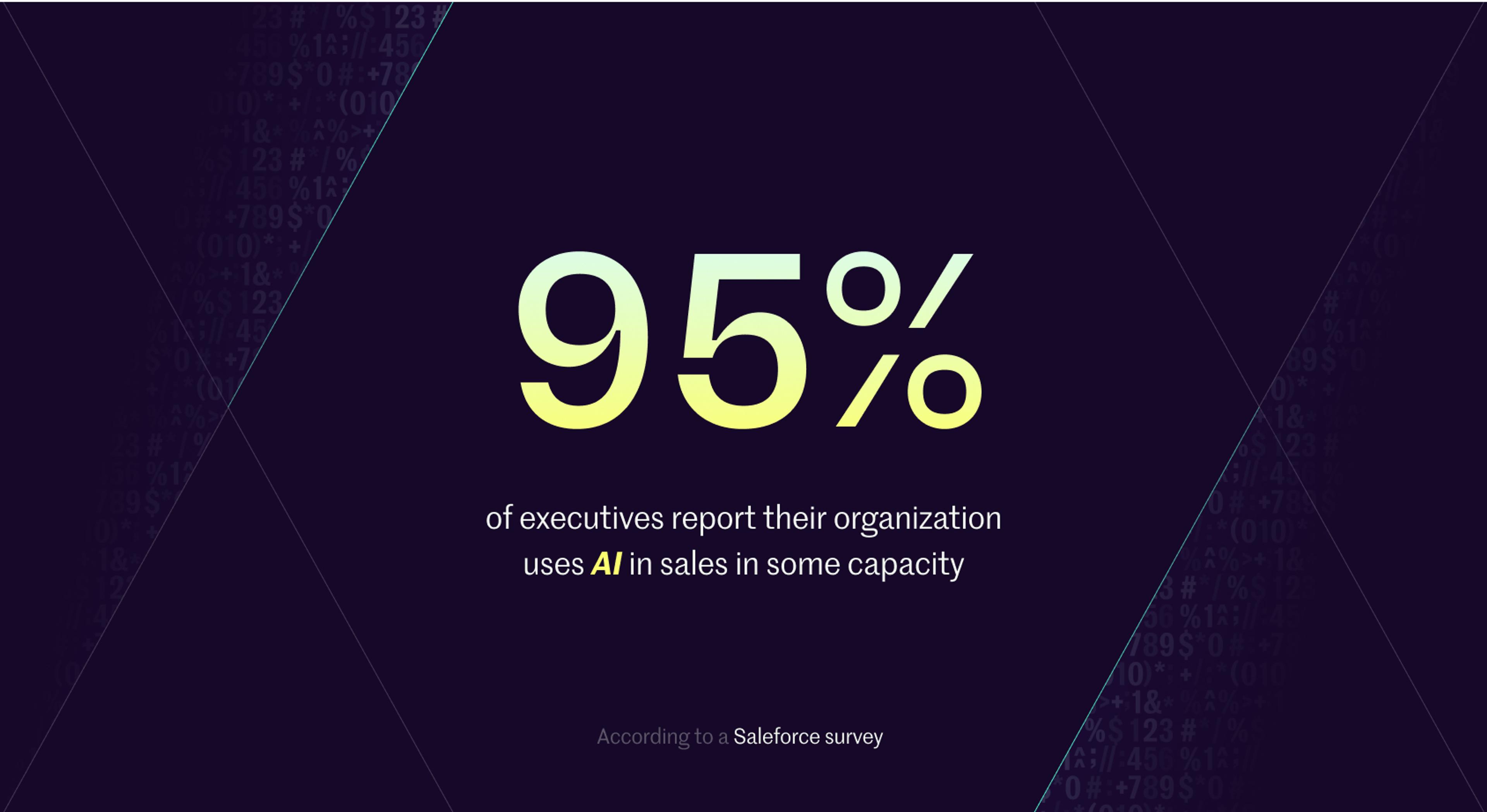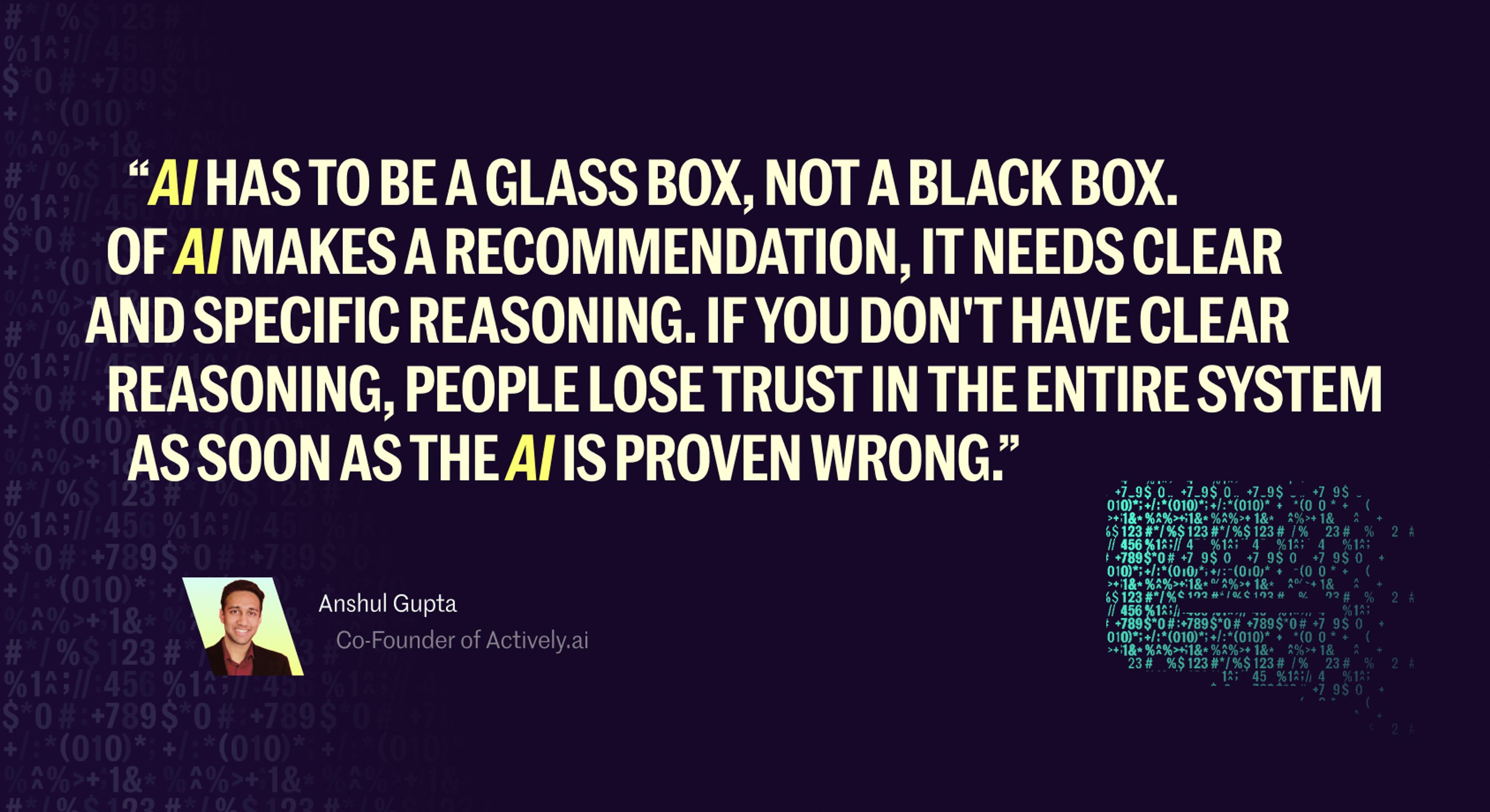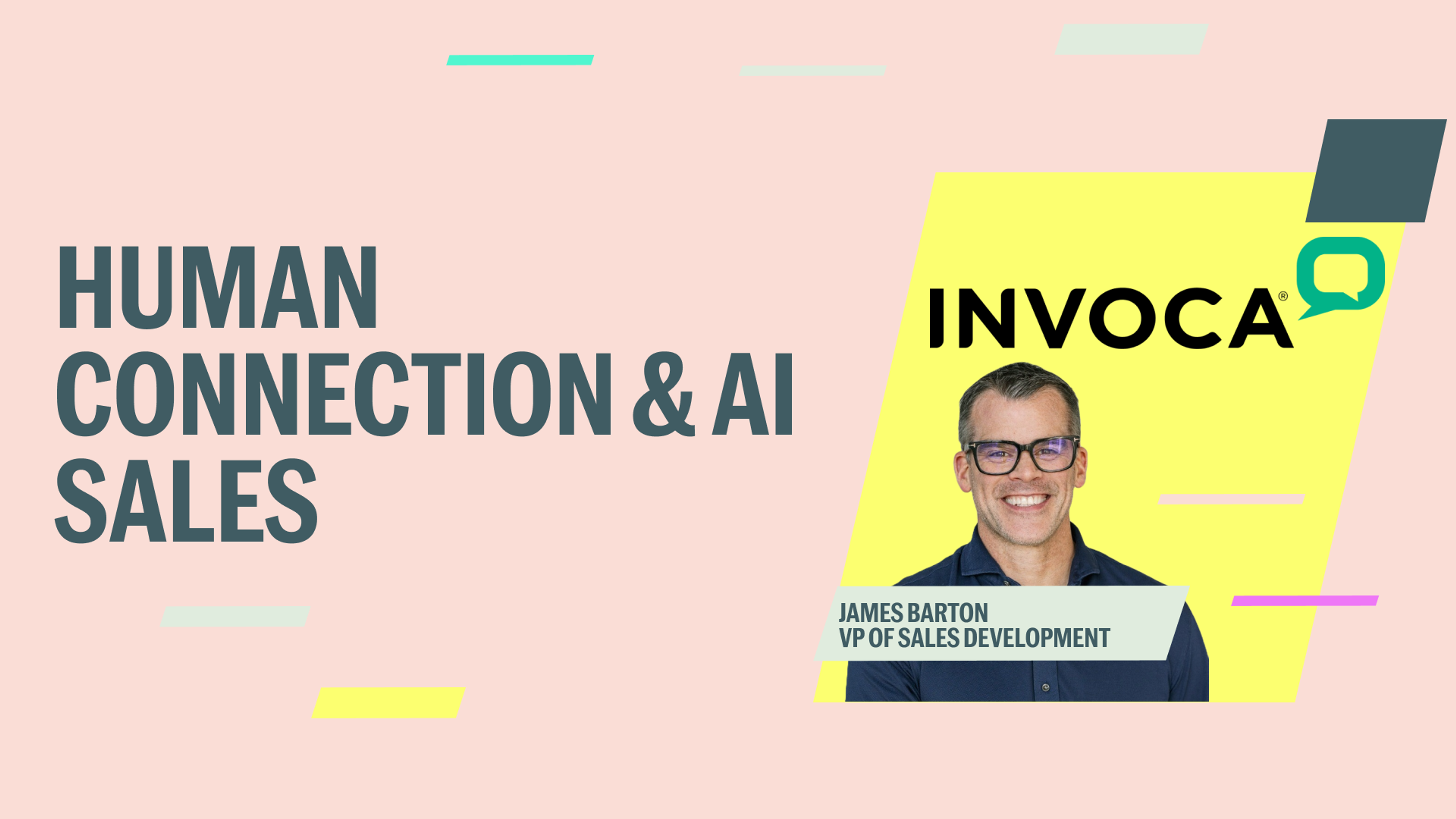Automation annihilation: AI and the end of sales development as we know it


Listen to audio version of the report here.
Watch Orum's AI in Sales Dev webinar here.
Executive summary
AI has become a table-stakes aspect of the sales process, as 95% of organizations use AI in sales in some capacity (Salesloft). Sellers agree that it can sharpen their focus as 78% of sales professionals agree that AI can help them spend more time on the most critical aspects of their jobs (HubSpot).
The rise of AI in sales directly correlates with lengthening procurement procedures, with customer acquisition costs rising in the last 12 months (Orum). AI is designed not to replace seller but to optimize how they spend their time. Currently, sellers only spend 28% of their time selling (Salesforce), often spending 25-30 hours weekly on administrative tasks.
AI’s power is dependent on sellers' data enrichment capabilities. It works best to keep humans involved in the sales process rather than eliminate them. This is especially true in more complicated sales processes, where buyers prefer to speak with a human seller when nuance is involved in purchasing.
The future of the seller is directly related to the future of AI. They are intertwined, and while AI will likely replace some sales roles, it will ultimately create a better experience for buyers and sellers alike.
Automation annihilation: AI and the end of sales development as we know it
A quick Perplexity.ai query of “How many AI companies are there?” yields a result that states, “There are over 250 million companies worldwide that are using or exploring the use of AI in their business operations”. 77% of companies are either using or exploring AI currently. AI-driven business processes aren’t the far-off future. They’re the present.
The tech industry has made such a big bet on AI because it has the potential to solve real business problems substantially faster than humans can alone. The B2B SaaS space is leading the AI revolution as organizations work to drive ever-greater optimization. For sellers, however, this optimization leads to a much larger question.
Will AI take my sales job?
We’ve interviewed sales leaders, experts, and founders in the AI space and analyzed recently released research to understand the current and future state of the AI and sales landscape.
State of AI in Sales in 2024
According to a Salesloft survey, 95% of executives report their organization uses AI in sales in some capacity, and 84% say their company has used generative AI in sales in the past year. A similar survey run by HubSpot notes that 78% of sales professionals agree that AI can help them spend more time on the most critical aspects of their role.
What may seem like a sudden rise in AI usage is, in reality, something that has been infiltrating the industry for years. The rise of AI represents the latest move to optimize what’s possible with existing resources. SaaS sales are expensive, and crowded markets continue to increase costs.

The cost of sales
Data points from our State of Sales Development report indicate why organizations seek to automate the sales process and reduce the cost of sales.

The pre-sales process is too time-consuming
Another factor connected to the growth of AI is administrative creep, which grows as deals increase in complexity. The larger the deal, the more tasks that need to be completed, leading to more “busy” work by sales reps. According to Salesforce, sellers only spend 28% of their time selling. The rest of that time is spent handling these tasks that need to be done but reduce the ability to connect.
Every sales leader we spoke with said their SDRs spend 25-30 hours per week on account research, recording call notes, CRM documentation, email writing, and social connections. These same leaders say their reps spend, on average, ten hours per week on the phones, connecting with prospects and booking meetings. The goal of any sales leader should be to reverse these metrics.
Average daily hours spent by reps:
- Account research/prospecting: 3-4
- Calling/active outreach: 1-2
- Post outreach tasks/follow-up/documentation: 2-3
For Erin Jones, a RevOps leader at Auctane, AI's power lies in freeing up reps. “50% of a seller’s time is administrative. It’s writing cadences, updating a CRM, and ensuring their pipeline is current. Automating all that frees up time to prospect more actively and have more conversations.”
There is a long-held belief that these hours spent doing this research are necessary to create personalized outreach, thus increasing the likelihood of a prospect responding. However, the 95-5 Rule remains true, and the vast majority of the market isn’t actively purchasing at any given time.
AI tools can initiate personalization by scraping websites, learning if organizations are hiring, and ingesting a 10-K report to understand current business metrics. A sales rep extends that personalization by asking deeper discovery questions to understand their needs better. Sales reps can uncover nuanced aspects of their GTM strategy, feelings about their current tech stack, and sentiments about tracking towards goals.

How sellers use AI
According to a Deloitte survey, 82% of respondents believe that AI helps them improve job performance and increase job satisfaction.
AI should remove the feeling every salesperson has when they wake up in the morning and say, “Who am I going after today?” At its best, AI eliminates the guesswork involved in prospecting, identifies those who are ready to buy and interested, and automates the follow-up tasks for prospects who aren’t.

Growth Marketing Consultant and Fractional CMO Blake Menezes shared, “One of the biggest areas where AI will gain traction over the next year is incorporating it into insights analysis and visualization components of pipelines. This will clarify what content, touchpoint, or action drives success while eliminating the time lag to acquire that information.”
The current challenge for sales leaders is a flooded AI landscape. There is such a wide array of tools available that it can create analysis paralysis when determining what to put in your tech stack. Blake continues, “We’re at the moment where we’re all experimenting with multiple tools. AI needs to define the next best action you should take, and the sales rep executes those actions.
But is that actually happening?
Sales professionals generally see the usefulness and necessity of AI in their daily processes. Still, situations arise where the tooling is almost too effective at outreach but needs more essential nuance. More powerful AI means that sellers can increase the value and frequency of a touchpoint. However, more automated messages don’t mean people will buy more.
One of the founders we spoke with mentioned an interesting scenario when discussing using AI to generate more informed, engaging outreach. “We’re facing a problem currently where we’re able to get in front of prospects because our outreach is so well targeted, but they don’t need the solution we offer. They tell us that they responded because of the quality of our touchpoints, which is great, but it doesn’t result in a sale.”
AI isn’t doing its job if it entices people to speak with you, but those people aren’t in the market. The value of AI is the time it saves, but it also needs to generate pipeline. The benefits of AI for sales reps are clear. The benefits of AI, when sales reps are removed from the process entirely, are murky at best.
Smart leaders are already understanding where that balance is needed.
The one thing leaders are doing to implement AI in 2024
Business mapping is the key to successfully implementing AI into your sales process. You can’t understand where you can optimize customer acquisition if you don’t understand what’s most important and what’s most time-consuming for your sellers.
Above, we highlighted sales reps' average time on administrative tasks surrounding their outreach efforts. While this is a great place to start, every organization will have a different process, so it’s pivotal that you dedicate the time to understanding every aspect of your own.
Business Process Mapping isn’t just about determining the time spent on tasks. It’s about understanding which tasks are vital for building pipeline. If personalization and conversations are essential for you, then AI implementation should be about maximizing the time your reps can be on the phone through platforms like Orum.
Tools like Mutiny and Warmly can ensure a personalized website experience if your customers come through a self-guided buyer's journey. Copy.Ai and Wrench.Ai are great for organizations focused on social selling. UserGems and Deeto help create awareness through customer-generated content if your prospects come through community.
AI can automate every aspect of the sales funnel, but understanding where the automation best optimizes your prospect’s experiences starts by understanding what it takes to add those prospects to your pipeline.
AI’s multifaceted benefits for leaders
Forbes wrote about the need for AI for sales leaders in 2021, and the sentiment has only grown. According to Salesloft, 97% of leaders say working with tech vendors with an AI strategy is important.
Leadership needs analytical tools to make informed decisions. This is where AI thrives. Currently, the market is flooded with platforms. Blake believes this will change. "At the moment, leaders are Analyzing tools and cadences to see what’s working. Once the market understands what's working, we’ll see a consolidation in the next 12-18 months.”
Anshul Gupta, Founder of Actively.ai, agrees. “Organizations who work with the fastest growing companies and show how their AI is part of that wave of growth will be the ones that last and rise.”
From a leadership standpoint, the most dramatic shift driven by AI is understanding that you no longer have to double your team to double your output. AI enables leaders to provide fewer reps with more tooling, optimize efficiency, and improve overall performance numbers. This reduces headcount volatility, provides more opportunity and value for the remaining reps, and eliminates the guesswork connected to forecasting pipeline.
Buyers trust AI…to a point
Informed buyers are becoming hesitant to engage with organizations because of the tracking capabilities built into every interaction. Account research tools have become so powerful that every engagement is noticed, and one founder worries about the repercussions.
“There is more noise than ever. People are relentlessly misusing AI to spam inboxes. Many bad actors use AI to increase their messaging output without understanding whether these prospects are interested. It’s already gotten to the point where I don’t engage with any content unless I’m prepared for the outreach it will trigger.”
Another leader discussed human-to-human compassion and emotional intelligence when sharing their thoughts on automated selling. “As a buyer, it’s hard to know whether a ‘person’ reaching out to me is actually a person and whether they care about me and my organizational needs. I don’t mind the automated communication. I want to know when a seller reaches out that they’re a person. I feel more obliged to a person than a machine not to waste their time.”
Blake is less concerned about whether or not a seller is AI, but rather if that AI has a genuine value proposition. “If an AI rep reaches out to me when I am contextually ready to purchase the solution they’re offering, then I don’t see an issue with it. The issue will be that if organizations use AI outreach to spam inboxes. Then it won’t replace anyone.”

There is a tipping point in the purchasing process where the buyer wants to connect with a human being. This tipping point is often connected to the price point or complexity of the solution implementation. The more complex the implementation process, the greater the need for a human seller. They can ask deeper questions based on prospect needs, thus providing more specific value propositions.
Parthi Loganathan, Founder of Letterdrop, notes, “There is a price threshold, and it will differ for every organization, where a buyer will say, “I want a human involved in the process.” Depending on your pricing structure and go-to-market strategy will determine the necessity for sales representatives and what their roles need to be.”
AI dialers combine tech and trust
For years, email and phone-driven sales organizations have used AI-powered platforms to optimize rep productivity. While email inboxes have grown crowded and open rates have declined, the best way to sell remains through trust and relationship building, and picking up the phone is an essential step in that process.
Making phone calls might seem analog, even diametrically opposed to advancements like AI. The reality is that platforms like Orum implement AI much the same way as other aspects of the prospecting process–it automates the manual elements SDRs previously spent hours performing.
As Colin Specter, Orum’s VP of Sales, states, “AI brings sellers back to what they originally intended to do: build relationships and communicate. The goal of AI in our platform and other AI tools is to cut directly to the point where reps are having more conversations with prospects and, upstream, identifying who you want to have those conversations with.”
AI dialers are the crossroads between modern-day technology and the age-old understanding that we buy from those we trust. While they optimize rep dialing time, you must find ways to give reps more time to make those calls. Maximizing its effectiveness requires business process mapping and understanding what other aspects of the sales process can be automated.
From Orum’s State of Sales Development report:
- All 11 industries surveyed cite the phone as a top sales tool, but you can’t actively make calls if you spend hours daily on administrative tasks.
- Booking a meeting takes at least seven touchpoints, and reps need more time to perform those touchpoints and maximize opportunities.
- On average, SDRs generate pipeline for at least three AEs. Eliminating non-selling activities helps maximize the time they can spend actively prospecting.
Costs are up, and quotas are, too. Resource availability is down–And while funding for start-ups in Q1 2024 was significantly lower than last year, AI is one sector receiving increased funding.
AI’s capabilities can positively impact nearly every aspect of the sales process but rely upon data inputs to yield results. The most enriched sales data comes from interactions with prospects, meaning AI relies upon human sellers and improves their processes.
Automation of administrative tasks directly ties into human-centric sales. The more active outreach your reps can do, the better data you’ll have for AI to create action plans, creating even more opportunities for your reps to call and connect with prospects. Understanding where automation can be most effective is a vital step in the process.
Will AI replace salespeople?
The short answer is yes.
Much like AI itself, the long answer grows in complexity every day.

AI is the current generation’s version of the computer, mobile phone, or tractor– It’s a tool that empowers those who adapt to use it while eliminating jobs for those who refuse to change. As Guillaume Cabane, Co-Founder of HyperGrowth Partners, said on our Bold Calling Live webinar, “Pure human connection will always be a key differentiator.”
While hard to quantify, trust, relationships, and emotional intelligence still matter; we believe they always will.
The evolving future of the Sales Development Representative
The evolution of AI will lead to a sales revolution. SDR work is emotionally taxing, and few want to do it long-term. By providing AI-powered tooling to individuals, you’re empowering reps to expand their capabilities. You’re enabling them to have more conversations with prospects, do more in-depth account research in less time, and be more capable.
By automating the process from prospecting to follow-ups, you’re giving reps more at-bats, more opportunities to pitch, and upskill their ability to create value-driven sales propositions. You’re eliminating the need to divide and conquer the sales funnel. In short, you’re building full-cycle account executives.

Nearly all of the sales and tech leaders interviewed for this report agreed that while AI will likely reduce the current SDR headcount, it will also increase the quality of those who remain. Like marketers who tend to become “generalists” as they advance, sellers will be given the tools to guide prospects through the entire buyer journey, from awareness to signing a contract. In short, it removes the division of labor that separates SDRs from AEs.
Salesforce leadership agrees. “By pulling in AI to save time on manual tasks, Sellers can focus on the human aspect of person-to-person selling. AI can’t read a person’s mannerisms… or do anything that builds that human element of trust. That’s why person-to-person selling isn’t going anywhere.”
The sales rep of the future is not mindlessly manually dialing prospects for hours on end, only to have one conversation per day. They are using AI to understand what prospects have needs they can solve and how to contact them. Based on more data and information, they generate new relationships with those prospects, ultimately creating greater trust. Crucially, they’re creating more of those relationships and spending more time on the human-centric nuances of the sales cycle because they have more time, thanks to AI.
AI is changing the way we understand the sales process in real time. But it’s not a doom-and-gloom dystopia where sellers go extinct. It’s creating a revolutionary present and future where sales professionals are more capable than ever in human history.
AI isn’t the end of sales. It’s an evolution of what it means to sell.





